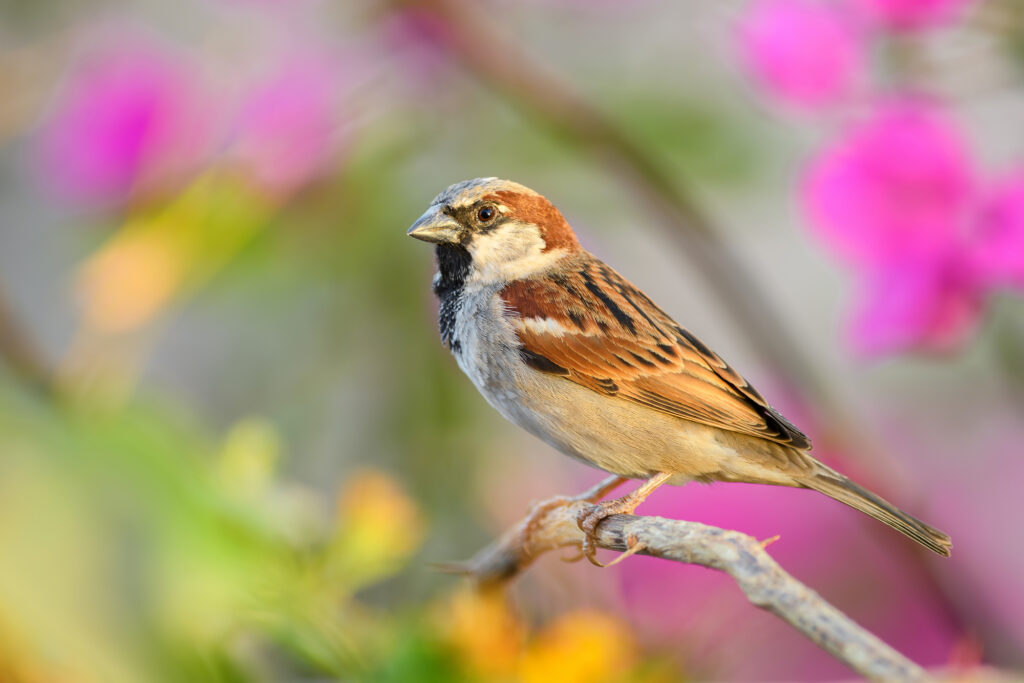Kentucky is home to gorgeous landscapes, fantastic old cities, incredible traditions, and rich culture. It’s also home to over 350 different kinds of birds! We wrote about 30 of these birds in our Kentucky Bird Guide.
Of those 350 birds, there are about 20 kinds of sparrows that spend at least part of the year in Kentucky. Some are here for the summer, some for the winter, and some stay all year. Others just stop by as they migrate between their winter and summer habitats.
Let’s take a look at the 20 sparrows bird watchers are most likely to spot in Kentucky.
What Are Sparrows?
Often called “Little Brown Jobs,” or LBJs for short, sparrows are small birds that make up the Passeridae family. Towhees, Buntings, and Larks are all part of the same family of sparrows.
They are usually brown with different amounts of streaking. Some of the common colors you might spot on a sparrow are black, gray, rufous, and yellow. These subtle colors make them great at camouflage.
They are usually between 5 and 7 inches long with short, sharp bills. The shape of the birds’ tails, wings, heads, legs, and bodies varies greatly from one kind of sparrow to the next.
Because sparrows are so small and flighty, it can be difficult to get a good look at them — and they are often confused for one another. But with a little practice, birders can definitely learn to identify the differences. When you start to look closely, you’ll see that each kind of sparrow is unique.
How Many Sparrows Are in Kentucky?
Our list of sparrows in Kentucky includes 20 different sparrow varieties, including some towhees and juncos.
It’s true that a rare, migratory vagrant may accidentally end up in Kentucky once in a while, but we’re focusing on the sparrows that are consistently in Kentucky every year.
We’re making the list easy to use by dividing these birds into four categories: year-round sparrows, summer-only sparrows, winter-only sparrows, and migratory visitors. The majority of Kentucky’s sparrows are here during the winter.
Questions to Help Identify Sparrows
Sure, identifying sparrows is a challenge – but it’s definitely doable.
We’ve put together a list of questions to help you take note of a sparrow’s physical and behavioral characteristics (this list can also be used for other birds, of course). If you’re not able to get a good picture or recording of the sparrow, make notes to answer the following questions:
- What color was the bird (face, chest, nape, flanks, tail, wings, belly, back, head)?
- What patterns were on the bird’s body and face (stripes, streaks, spots, patches, etc)?
- What was the bird’s silhouette?
- What part of Kentucky was the sparrow in?
- What kind of habitat was the bird in?
- What time of year was the sighting?
- What was the bird doing (hiding, scurrying, perching, singing, diving, eating, etc)?
- Was the bird eating anything?
With this information at your disposal, you will be able to identify the sparrow that you saw. Plus, such careful attention to the main characteristics of these little birds will help you learn and remember the differences between each of these sparrows.
Let’s get started on the list of 20 sparrows in Kentucky!
Year-Round Sparrows in Kentucky
4 different kinds of sparrows live in Kentucky all year long. Those sparrows are the Eastern Towhee, the Field Sparrow, the House Sparrow, and the Song Sparrow.
Eastern Towhee

- Pipilo erythrophthalmus
- ORDER: Passeriformes
- FAMILY: Passerellidae
- Length: 6.8-8.2 in (17.3-20.8 cm)
- Weight: 1.1-1.8 oz (32-52 g)
- Wingspan: 7.9-11.0 in (20-28 cm)
The Eastern Towhee male has a dark black head, neck, and back. His sides are rufous, and he has a white belly. Females are similarly patterned, but she is brown and rufous instead of black and rufous.
Eastern Towhees have a loud song, which sounds like the word “chewink.” In fact, they even get called a Chewink as their nickname.
They prefer to live in the safe undergrowth of Kentucky’s shrubby forests. They are year-round, widespread residents of the state. During the summer, they usually nest on the ground, or perhaps up to four feet above the ground in shrubs and small trees.
Field Sparrow
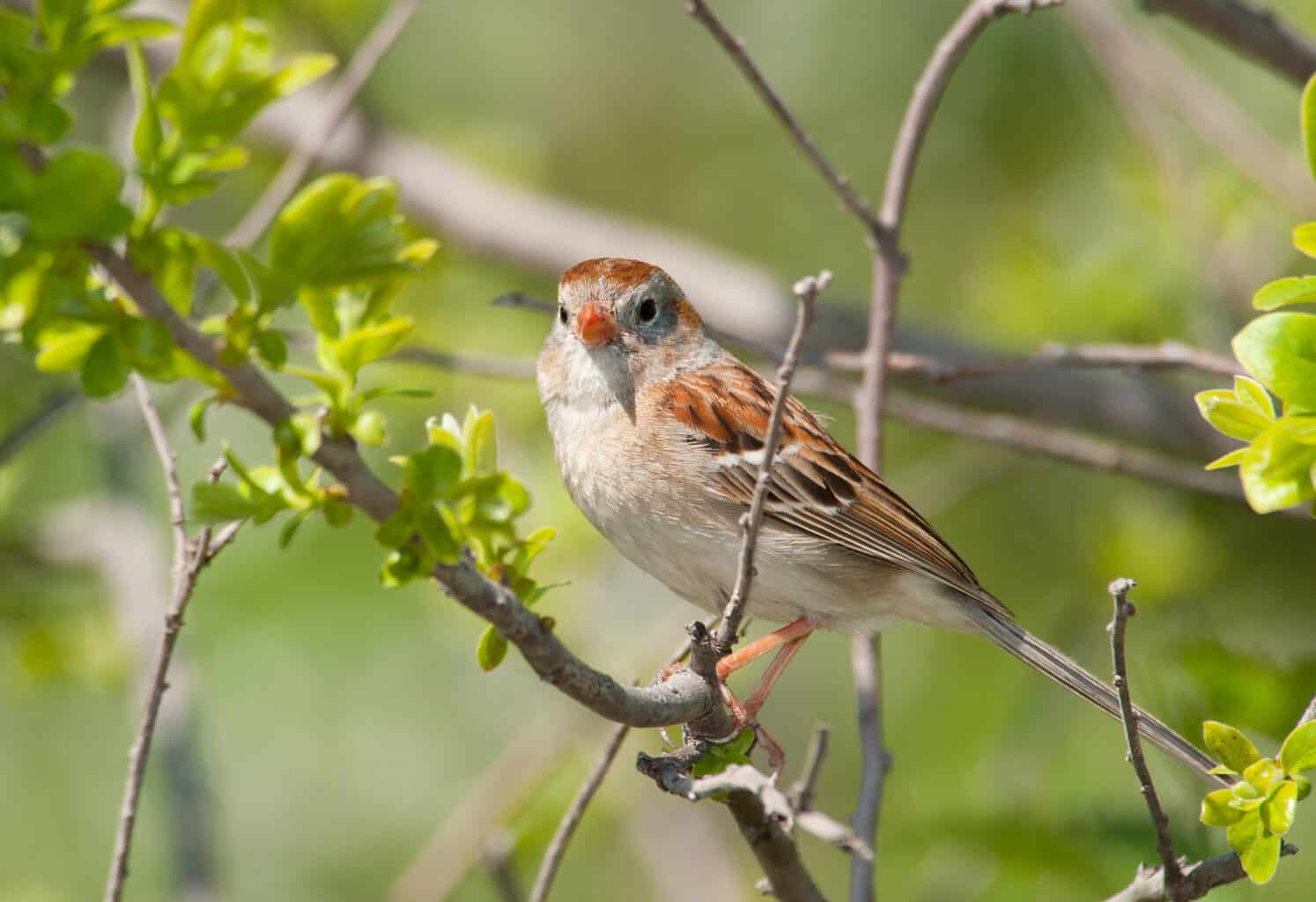
- Spizella pusilla
- ORDER: Passeriformes
- FAMILY: Passerellidae
- Length: 4.7-5.9 in (12-15 cm)
- Weight: 0.4-0.5 oz (11-15 g)
- Wingspan: 7.9 in (20 cm)
Field Sparrows are light gray with mixed-color streaking on their wings and backs. Their cap is rusty-brown, and they have a pink bill and white eyerings.
You’re more likely to encounter Field Sparrows in areas with minimal human activity. They live in fields, prairies, and other open lands. Because of the suburban sprawl in their main habitats, Field Sparrows have experienced an ongoing population decline for 50 years.
They are year-round residents throughout all of Kentucky. Despite their population decline, there are still plenty of Field Sparrows, and they are categorized as a Species of Least Concern.
House Sparrow
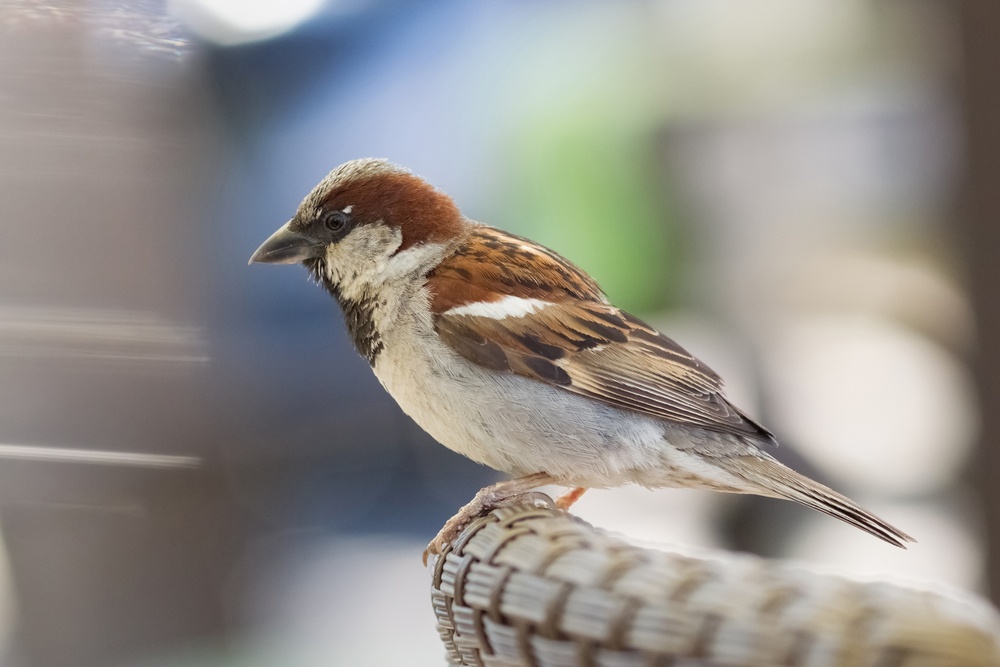
- Passer domesticus
- ORDER: Passeriformes
- FAMILY: Passeridae
- Length: 5.9-6.7 in (15-17 cm)
- Weight: 0.9-1.1 oz (27-30 g)
- Wingspan: 7.5-9.8 in (19-25 cm)
House Sparrows are widespread throughout the United States. They are found in 49 of the 50 states – all but Alaska. They are plentiful in Kentucky and can be found in the smallest towns and largest cities. Unlike sparrows that avoid people, House Sparrows have a preference for human habitats.
They live where they can easily access and nest in rafters, eaves, roofs, powerlines, and even stoplights.
The female House Sparrow is streaked in light and dark brown. The male, on the other hand, has a gray head with rufous on his crown and the back of his neck. His cheeks are white, and he has a black bib under his bill.
House Sparrows are aggressive little birds that compete with native species for territory and food.
Song Sparrow

- Melospiza melodia
- ORDER: Passeriformes
- FAMILY: Passerellidae
- Length: 4.7-6.7 in (12-17 cm)
- Weight: 0.4-1.9 oz (12-53 g)
- Wingspan: 7.1-9.4 in (18-24 cm)
The Song Sparrow looks different from one region to the next. The biggest difference is how much streaking they have: Song Sparrows that live in the desert are lighter and less streaky than coastal Song Sparrows, for example.
Generally, this species is brown with white streaking on the chest.
They live year-round throughout Kentucky. When it’s time to breed, they return to the exact same nesting ground as the previous year. Although males do stake out their territory, females tend to nest near one another, as their nesting area might be pretty small. You’ll find their nests either on the ground or up to 15 feet in a tree.
Song Sparrows have something in common with House Sparrows: they are comfortable around people. They will often nest in landscaping beds or right next to a house or building.
Summer Sparrows in Kentucky
In the summer, you may find the following sparrows in Kentucky: The Chipping Sparrow, the Grasshopper Sparrow, the Henslow’s Sparrow, and the Lark Sparrow.
Chipping Sparrow
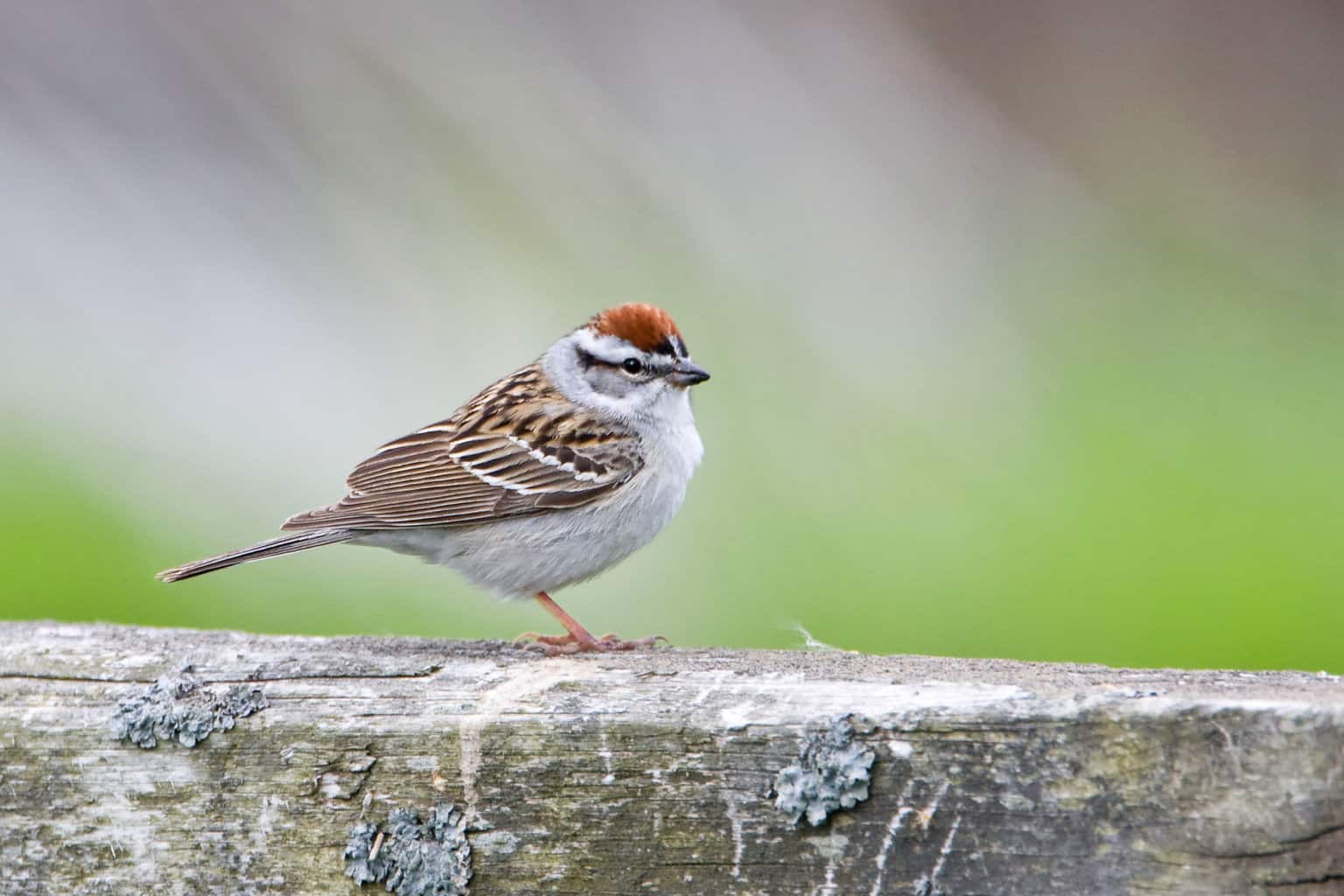
- Spizella passerina
- ORDER: Passeriformes
- FAMILY: Passerellidae
- Length: 4.7-5.9 in (12-15 cm)
- Weight: 0.4-0.6 oz (11-16 g
- Wingspan: 8.3 in (21 cm)
If you are anywhere in North America in the summer, you have a pretty good chance of seeing a Chipping Sparrow!
Chipping Sparrows breed across the entire North American continent and have a range that extends from northern Canada to southern Mexico, and from West to East Coast.
Their winter range is much smaller, limited to Florida, Mexico, and the Caribbean. Some live year-round in southern California, too.
The first thing to look for on a Chipping Sparrow is its rufous cap. It also has black eye stripes and dark streaks on the wings and back. Females are darker in color than males.
They are summer residents of Kentucky, where they have an insect-rich diet that includes grasshoppers, beetles, leafhoppers, caterpillars, and also some spiders.
They nest on the ground, in an open-cup shaped nest made from twigs, stems, leaves, roots, and weeds.
Henslow’s Sparrow
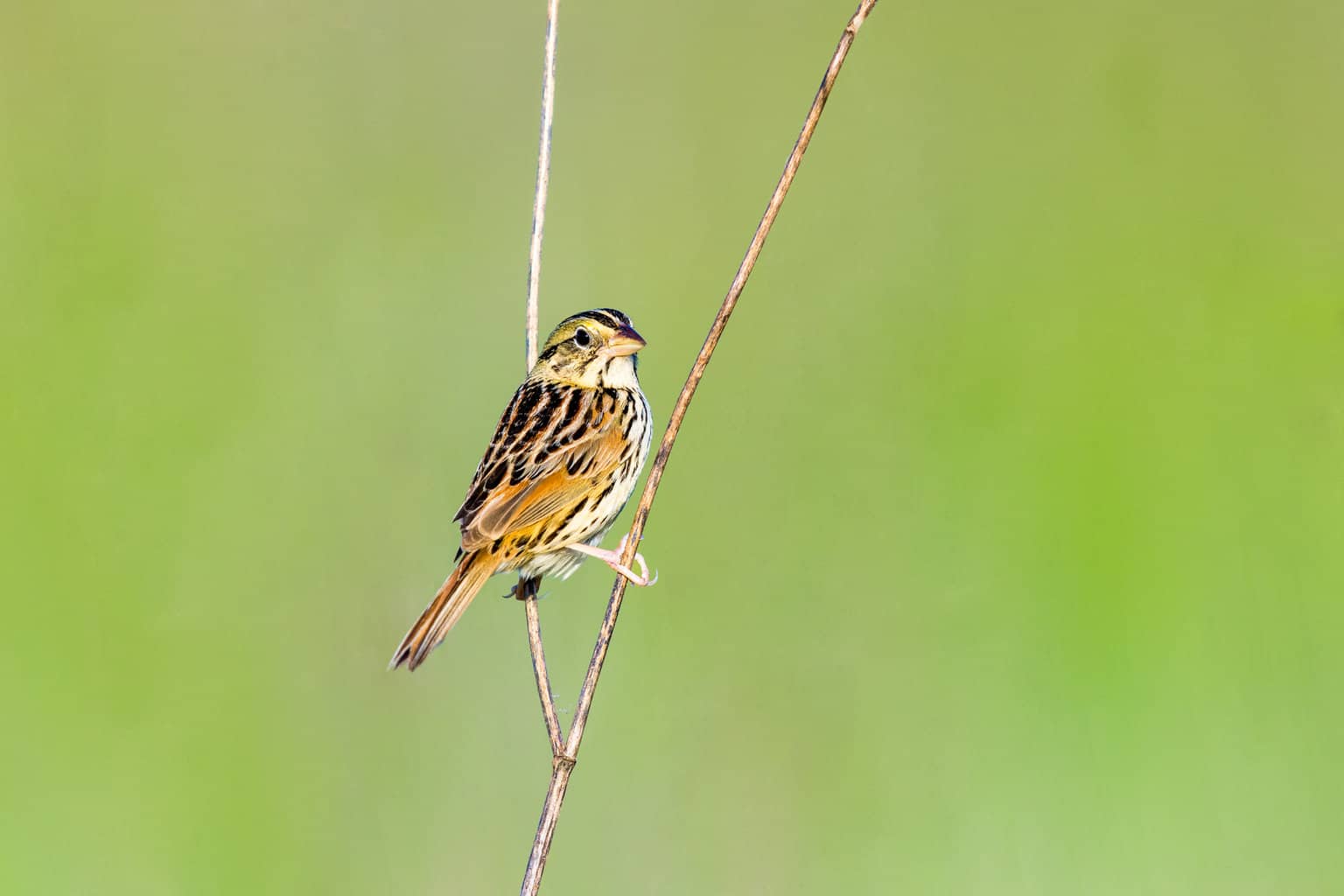
- Centronyx henslowii
- ORDER: Passeriformes
- FAMILY: Passerellidae
- Length: 4.7-5.9 in (12-15 cm)
- Weight: 0.4-0.6 oz (11-16 g)
- Wingspan: 8.3 in (21 cm)
Henslow’s Sparrows are plain, with some pale green coloring on their mostly buff-colored bodies. They do have some black streaking on their backs and wings. They are also incredibly quiet birds; their song is rarely heard.
They are ground nesters who disguise their cup-shaped nests by covering them with grass.
Henslow’s Sparrows are ground nesters who stay hidden from predators by covering their nests with tall grass.
During the summer, Henslow’s Sparrows eat plenty of bugs and insects, including caterpillars, beetles, crickets, stink bugs, and grasshoppers. They will even eat wasps – that’s one reason to keep them around! Like many other species of sparrows, they shift their diet to being seed-based in the winter.
They are summer residents of the northern half of Kentucky, but they really aren’t found at all in the southern half of the state.
Grasshopper Sparrow
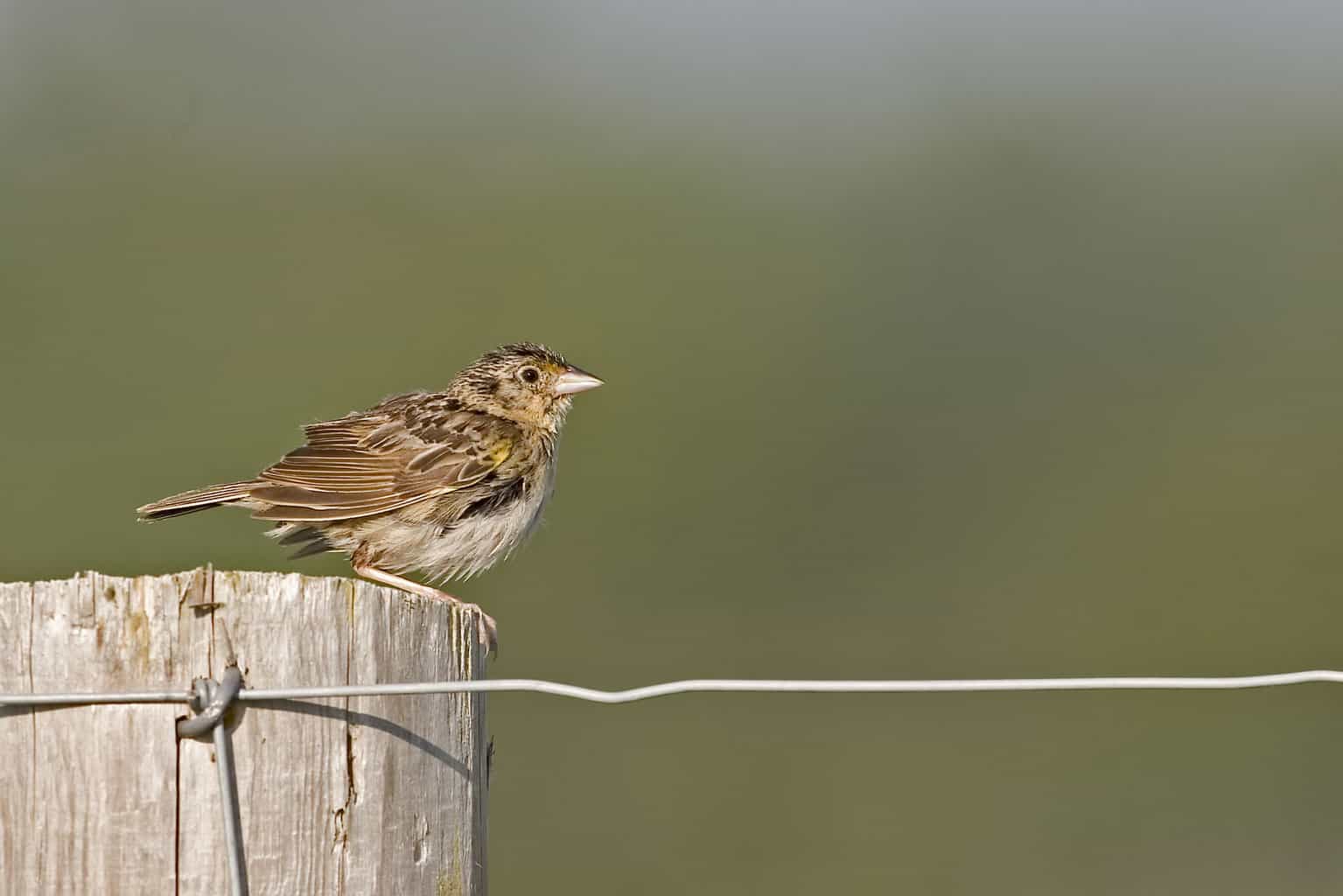
- Ammodramus savannarum
- ORDER: Passeriformes
- FAMILY: Passerellidae
- Length: 4.3-4.5 in (10.8-11.5 cm)
- Weight: 0.5-0.7 oz (14-20 g)
- Wingspan: 7.9 in (20 cm)
Even though Grasshopper Sparrows do eat grasshoppers, they get their name from their vocalizations, not their diet. They make a loud, buzzy-sounding call, which is similar to that of a loud summer grasshopper. Rare for sparrows, males also sing an additional song, which is squeaky but a little melodic.
Their coloring can range from tan and gray to light orange. Their heads are a little flat, and their necks are thick. They have short, stubby tails and large bills.
Most sparrows tend to hide among bushes and shrubs, but Grasshopper Sparrows are comfortable out in the open. They don’t spend as much time hiding, although they do stay close to shrubby areas in case they need to retreat.
They are summer residents of Kentucky and can be found throughout the state.
Lark Sparrow
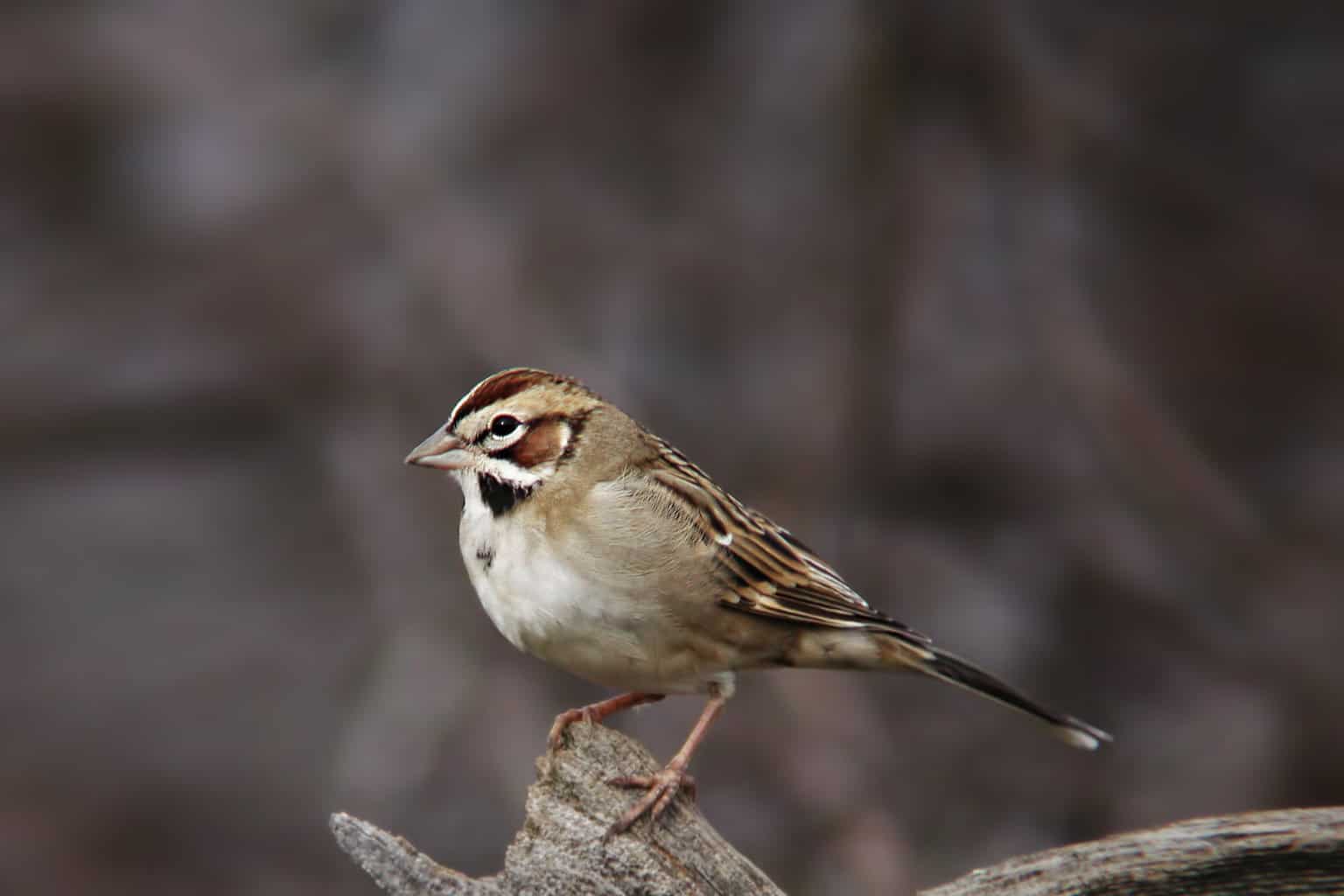
- Chondestes grammacus
- ORDER: Passeriformes
- FAMILY: Passerellidae
- Length: 5.9-6.7 in (15-17 cm)
- Weight: 0.8-1.2 oz (24-33 g)
- Wingspan: 11.0 in (28 cm)
Lark Sparrows are gray and bulky, with a brown-striped face and rounded tail. Look for a black chest patch to identify them easily.
They are experiencing a population decline, as well as a reduction in territory. Although they used to be found as far east as the Atlantic Ocean, today their breeding territory ends in southern Ohio.
Despite these declines, they are still a species of low concern to conservationists. There are an estimated 11 million Lark Sparrows in the world, and almost all of them are in North America.
In Kentucky, you will find them in the summertime in the western half of the state. They do not visit the eastern half. Watch for them foraging on the ground for insects during the summer.
Winter Sparrows in Kentucky
More sparrows are in Kentucky during the winter than during any other time. In addition to the year-round sparrows, you’ll also find these species in Kentucky during the non-breeding season: The American Tree Sparrow, the Dark-Eyed Junco, the Fox Sparrow, the LeConte’s Sparrow, the Savannah Sparrow, the Swamp Sparrow, the White-Crowned Sparrow, and the White-Throated Sparrow.
American Tree Sparrow
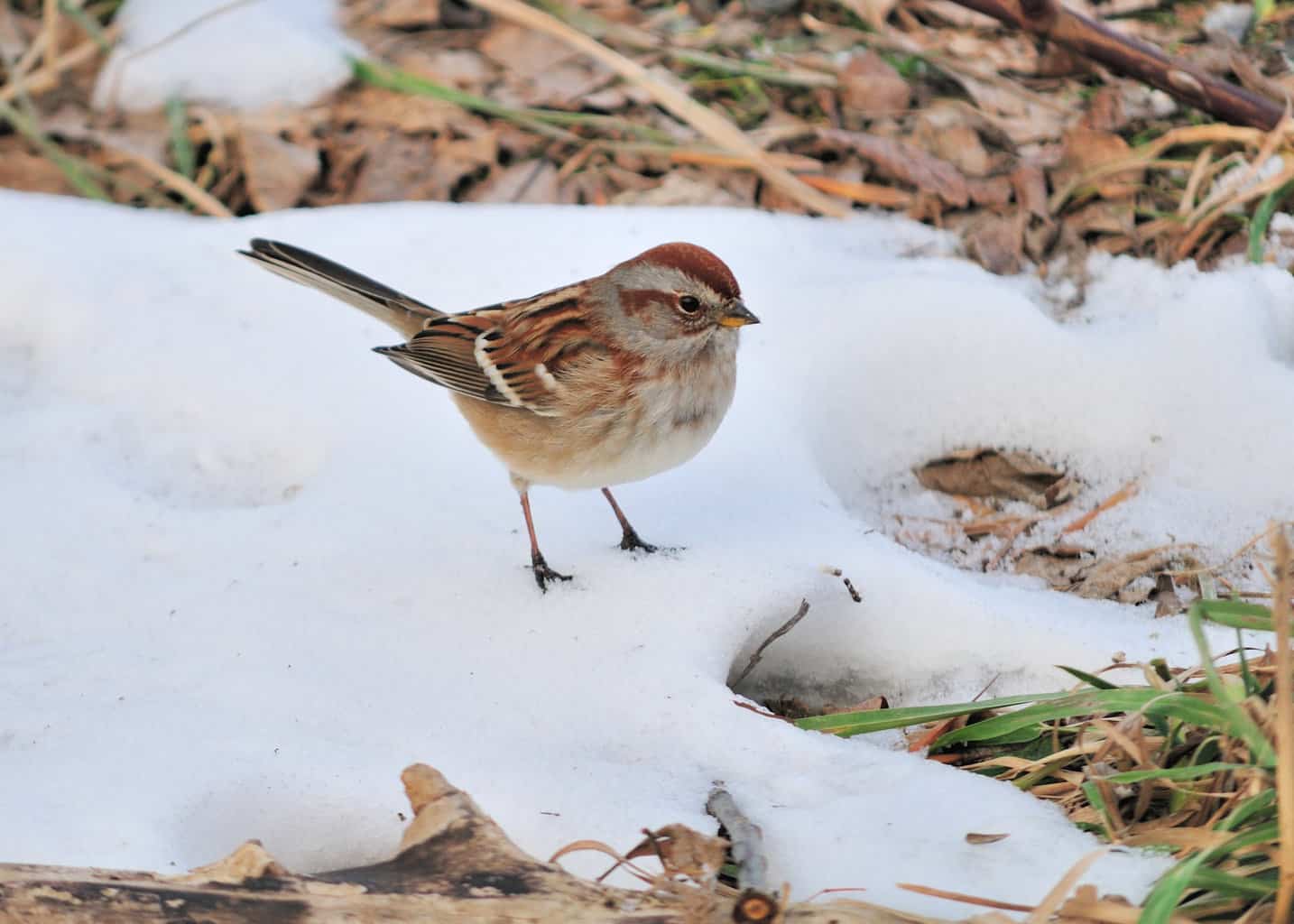
- Spizelloides arborea
- ORDER: Passeriformes
- FAMILY: Passerellidae
- Length: 5.5 in (14 cm)
- Weight: 0.5-1.0 oz (13-28 g)
- Wingspan: 9.4 in (24 cm)
Although some American Tree Sparrows have a red breast patch that makes them easy to spot and identify, others of this species lack that distinctive marking. They are mostly gray with striped wings and a reddish-brown crown.
Most sparrows choose a different kind of habitat for their breeding months and winter months. However, American Tree Sparrows actually choose the same kind of habitat in both environments. In the northern tundra where they breed and in the US where they spend the winter, they choose open land near woods, water, and weeds.
They can be found throughout Kentucky, all winter long.
Dark-Eyed Junco
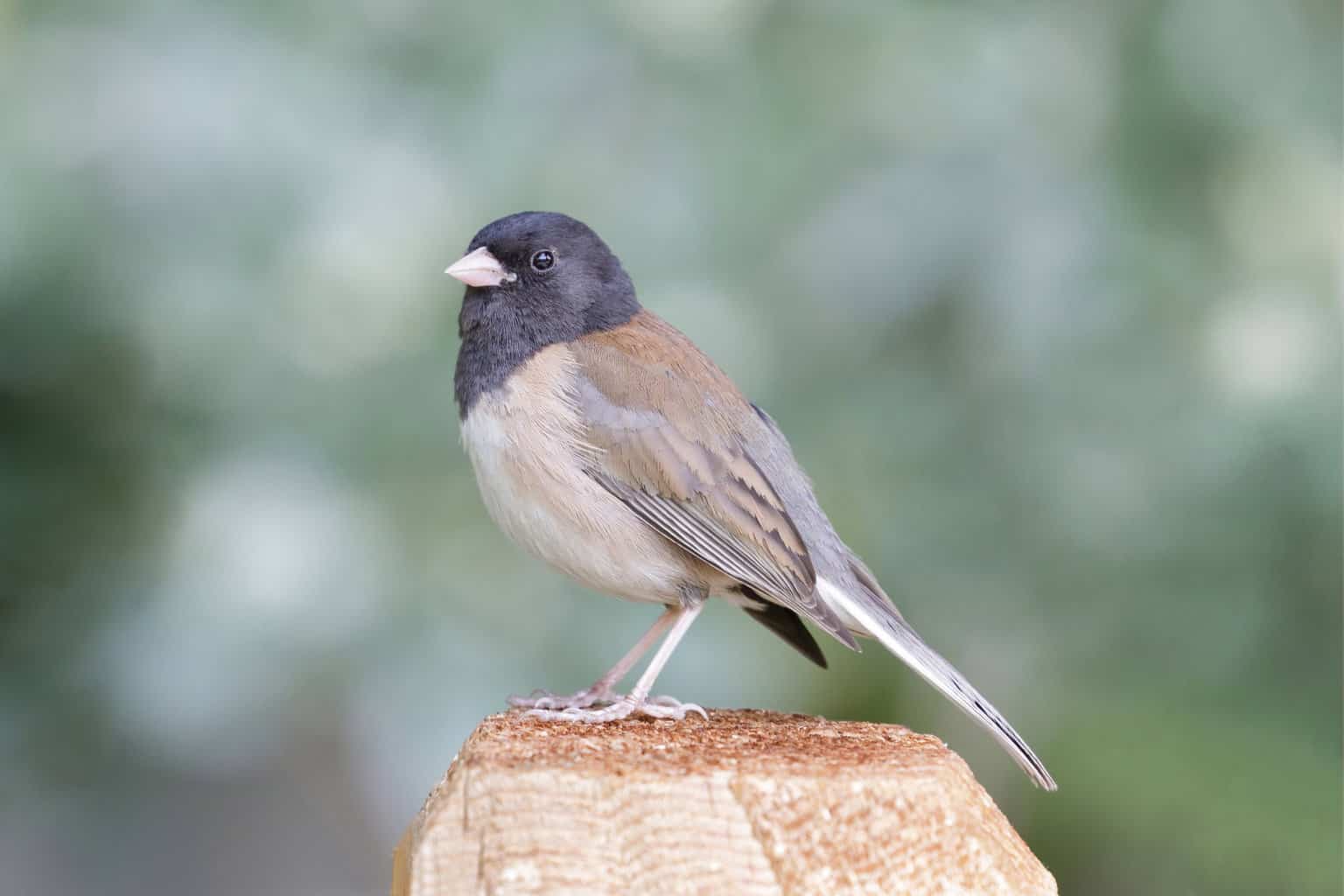
- Junco hyemalis
- ORDER: Passeriformes
- FAMILY: Passerellidae
- Length: 5.5-6.3 in (14-16 cm)
- Weight: 0.6-1.1 oz (18-30 g)
- Wingspan: 7.1-9.8 in (18-25 cm)
Dark-Eyed Juncos are one of the most common birds in North America. They are associated with the arrival of winter in many states, which earns them the nickname “Snowbirds.”
They are dark gray on top – back, head, and wings – and white or grayish-white on their undersides. They have a rounded body shape.
In Kentucky, they winter throughout the state. A small pocket of land in the southeastern corner of the state is also home to a year-round population.
You’ll find them in coniferous forests, as well as in parks and woods. They forage in open fields and backyards, and they are one of the most frequent visitors to backyard bird feeders in the winter. They will eat almost any seed-based food that you put out for them.
Fox Sparrow

- Passerella iliaca
- ORDER: Passeriformes
- FAMILY: Passerellidae
- Length: 5.9-7.5 in (15-19 cm)
- Weight: 0.9-1.6 oz (26-44 g)
- Wingspan: 10.5-11.4 in (26.7-29 cm)
Fox Sparrows are a little tricky because they vary so much from region to region. They can be light gray with a bit of red striping on their chest and back, or they can be almost entirely red because of so much streaking.
They also have brown chest spots, which can help you recognize them regardless of the saturation of their streaks.
Fox Sparrows are North American natives, but they have also been found as far as Germany, Greenland, Iceland, and Italy. That’s probably because they hopped onto a ship and unintentionally traveled abroad. Fox Sparrow communities have not been established in those areas, though.
In Kentucky, you can find Fox Sparrows throughout the entire state in the winter. You’ll find them in forests and any scrubby habitat, as well as visiting backyard feeders, where they make a mess by kicking around leaf litter.
LeConte’s Sparrow
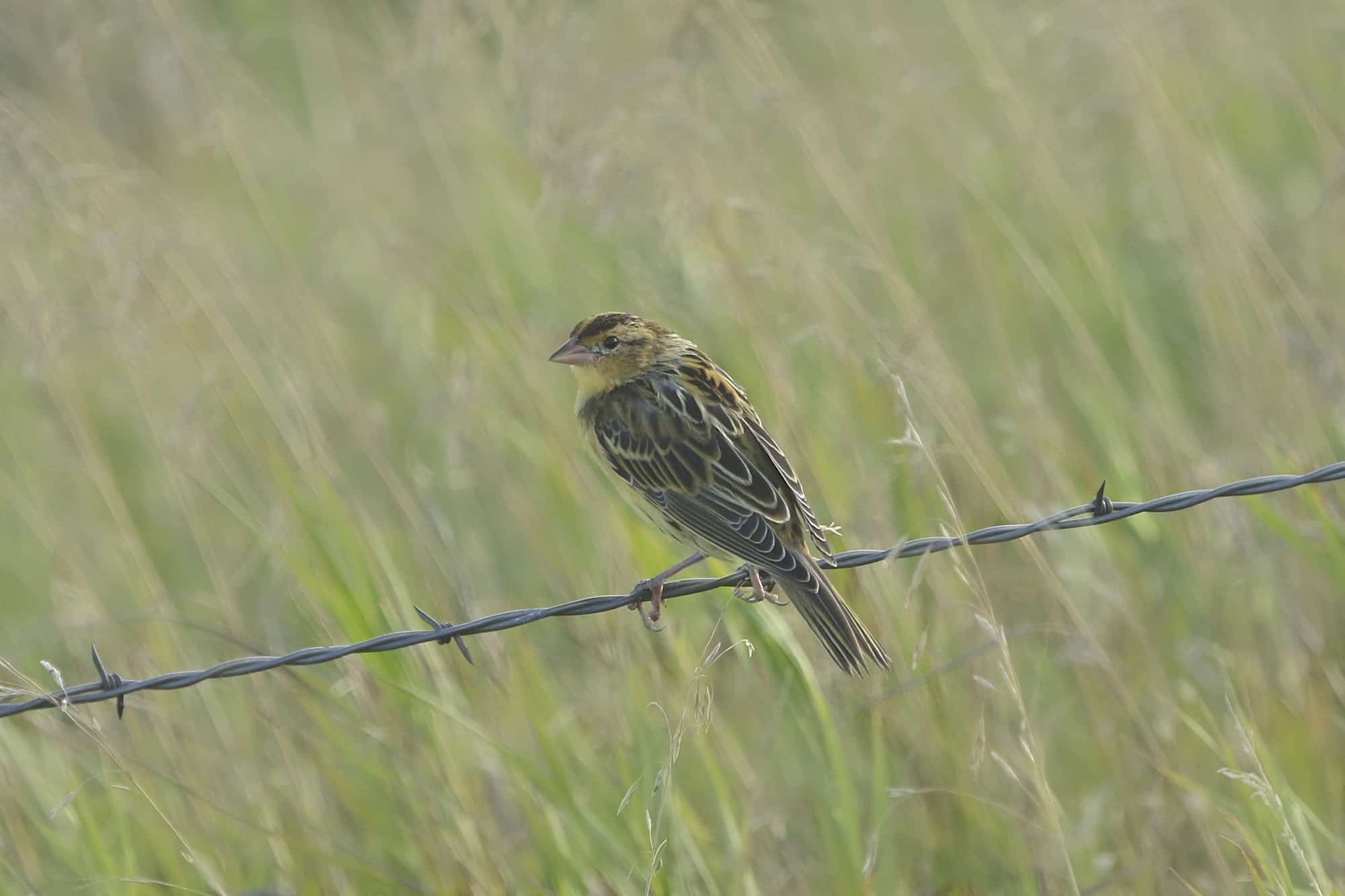
- Ammospiza leconteii
- ORDER: Passeriformes
- FAMILY: Passerellidae
- Length: 4.7-5.1 in (12-13 cm)
- Weight: 0.4-0.6 oz (12-16.3 g)
- Wingspan: 6.3-7.1 in (16-18 cm)
LeConte’s Sparrows are buffy-orange, with darker coloration on the head and breast. They have black streaking on the wings and back, as well as a grayish-purple spot on the neck, a white belly, and a gray bill.
They build their nests on the ground or about a foot above the ground, constructing a cup-shaped nest in a thick clump of dead grasses, including aquatic grasses. Their habitat includes wet marshy grasslands and sedges.
LeConte’s Sparrows are very secretive birds that are rarely seen by people. If you want to see them in Kentucky, your only real opportunity is in the Jackson Purchase area during the winter. A small number will also migrate through the western edge of Pennyroyal.
Swamp Sparrow
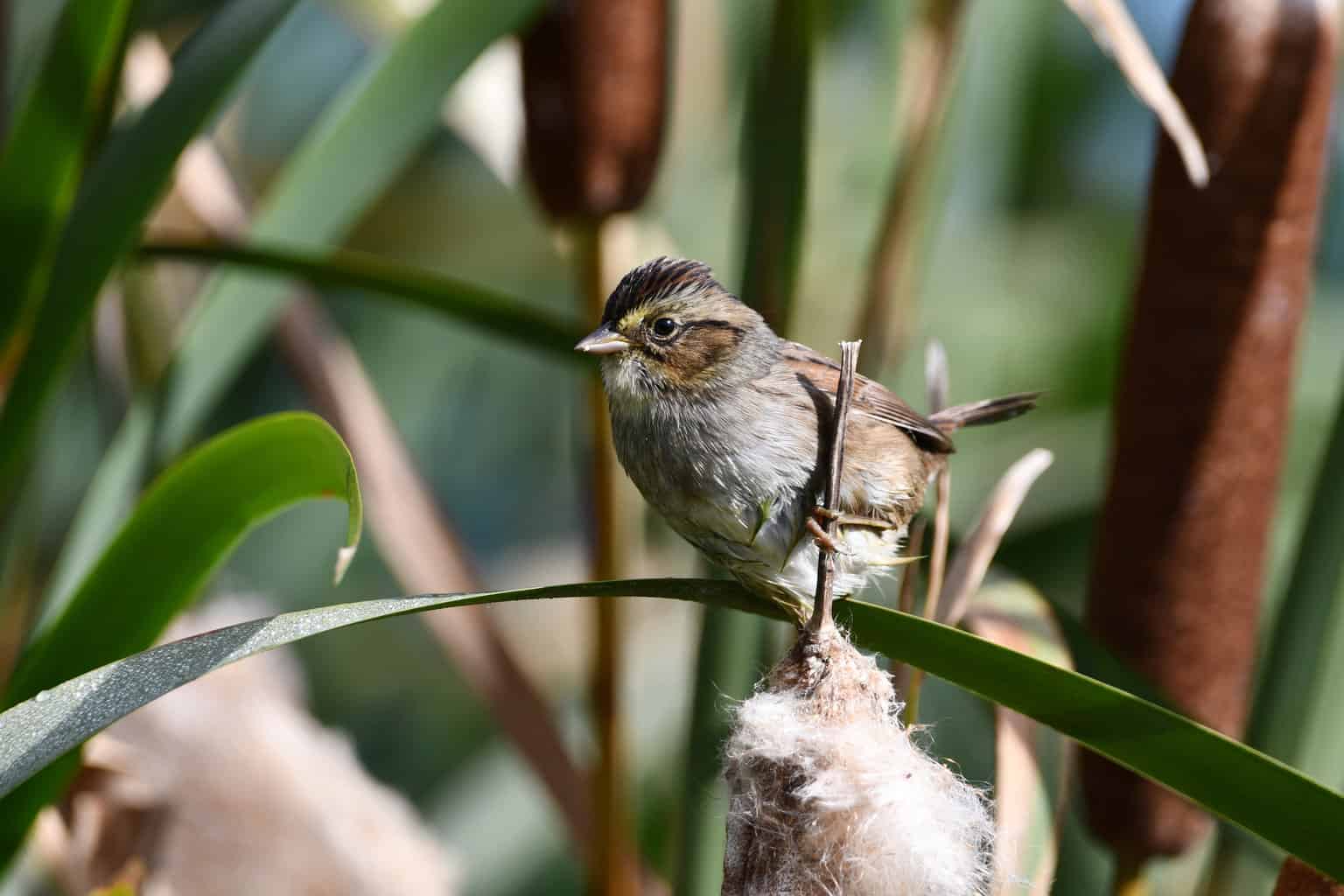
- Melospiza georgiana
- ORDER: Passeriformes
- FAMILY: Passerellidae
- Length: 4.7-5.9 in (12-15 cm)
- Weight: 0.5-0.8 oz (15-23 g)
- Wingspan: 7.1-7.5 in (18-19 cm)
The Swamp Sparrow has a long tail and a rounded body, giving it a silhouette that is similar to the more widely known Song Sparrow.
They are dark gray and white with a rusty-brown crown and wings.
Swamp Sparrows live in wetlands, usually in dense underbrush. They have long, strong legs to help them forage through the mud and in the aquatic grasslands for food.
Their winter habitat includes all of Kentucky.
White-Crowned Sparrow
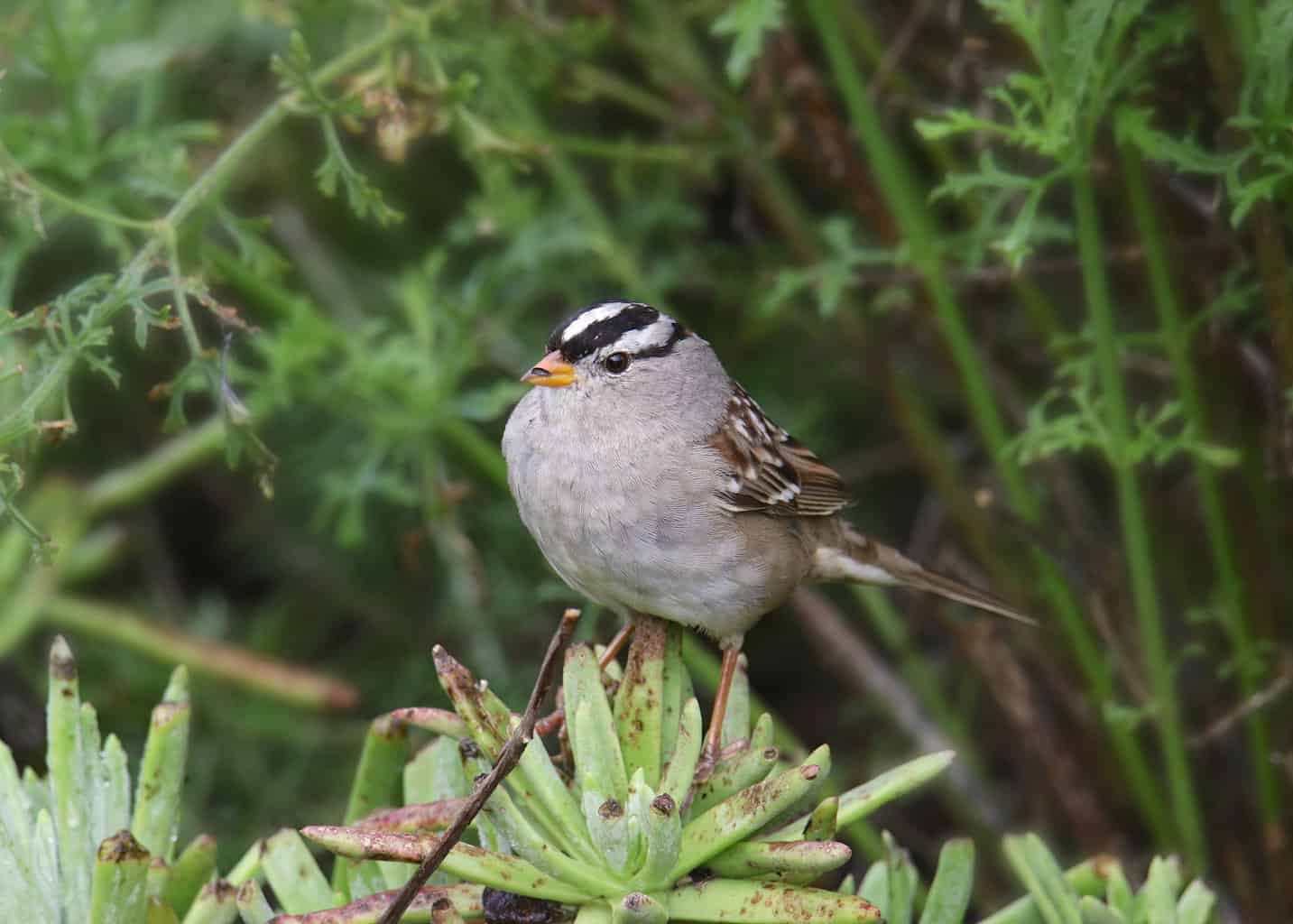
- Zonotrichia leucophrys
- ORDER: Passeriformes
- FAMILY: Passerellidae
- Length: 5.9-6.3 in (15-16 cm)
- Weight: 0.9-1.0 oz (25-28 g)
- Wingspan: 8.3-9.4 in (21-24 cm)
The White-Crowned Sparrow‘s dramatically patterned head is striped in black and white (juveniles are brown and white instead). The rest of the bird’s body is streaky and grayish-brown. They have pink or yellow bills.
Although they live as far north as the arctic Canadian tundra, they spend their winter in much of the US, including Kentucky. They are found throughout the state, usually in thickets and weedy winter fields, or along the road and in backyards. This habitat gives them plenty of covered and uncovered ground for foraging and hiding.
Watch for their behavior of “double-scratching,” which is when they hop backward and forward to find their food. When they hop backward, they will flip over a leaf. This allows them to see what was hiding underneath, and then they hop forward to snatch it up.
White-Throated Sparrow
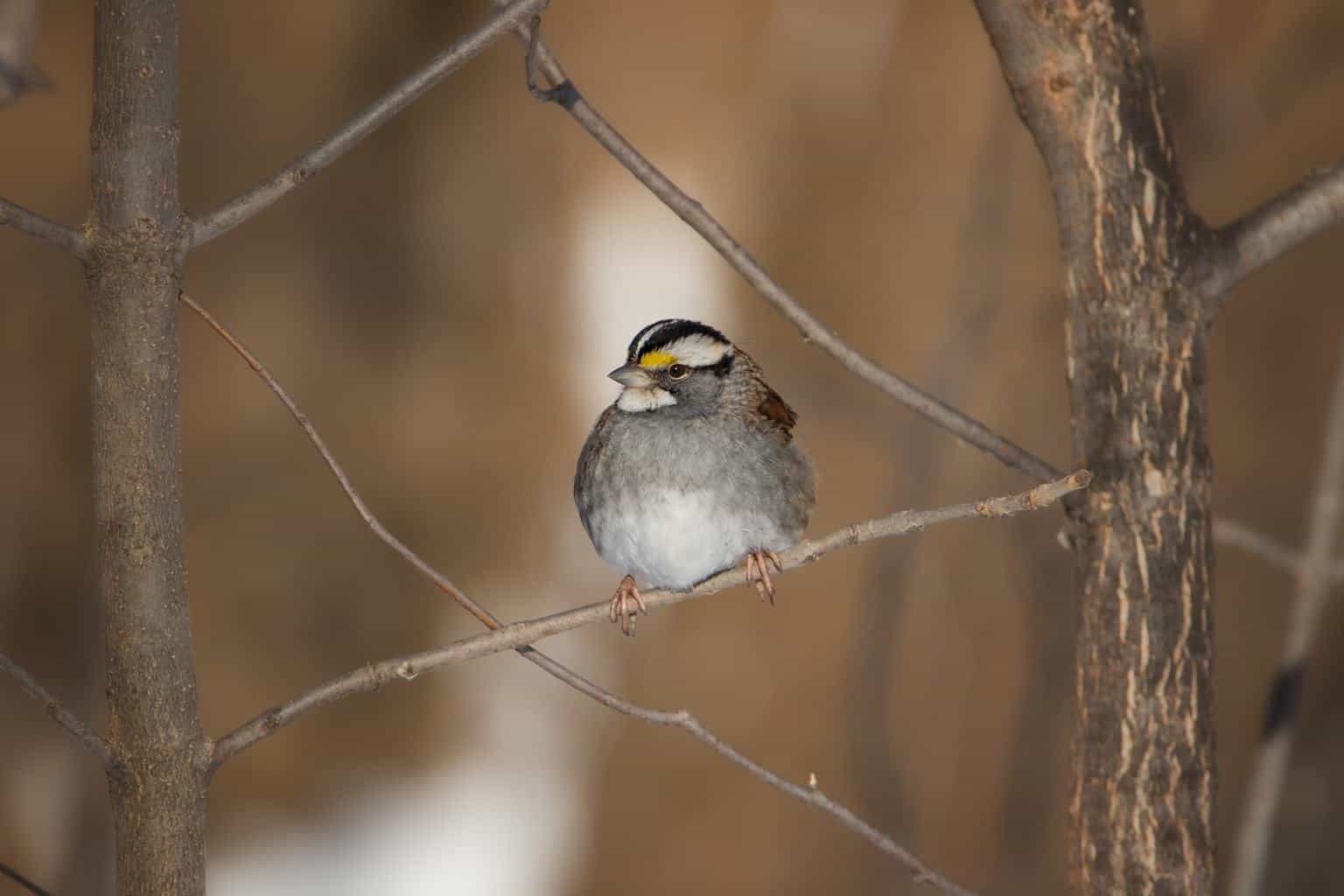
- Zonotrichia albicollis
- ORDER: Passeriformes
- FAMILY: Passerellidae
- Length: 6.3-7.1 in (16-18 cm)
- Weight: 0.8-1.1 oz (22-32 g)
- Wingspan: 7.9-9.1 in (20-23 cm)
There are two morphs of White-Throated Sparrows: white-crowned and tan-crowned. They are pretty easy to recognize, thanks to their bright white throat and their yellow lores (the area on the sides of a bird’s head).
They are known for reproducing with Dark Eyed-Juncos and creating a dull gray hybrid that has white outer tail feathers.
Listen for their distinctive song, even throughout the winter. They are often found in flocks of other White-Throated Sparrows.
They can be found throughout Kentucky during the winter.
Migration-Only Sparrows in Kentucky
A handful of sparrows are found in Kentucky exclusively during their winter and spring migrations. These are the Lincoln’s Sparrow, the Nelson’s Sparrow, the Savannah Sparrow, and the Vesper Sparrow.
Lincoln’s Sparrow
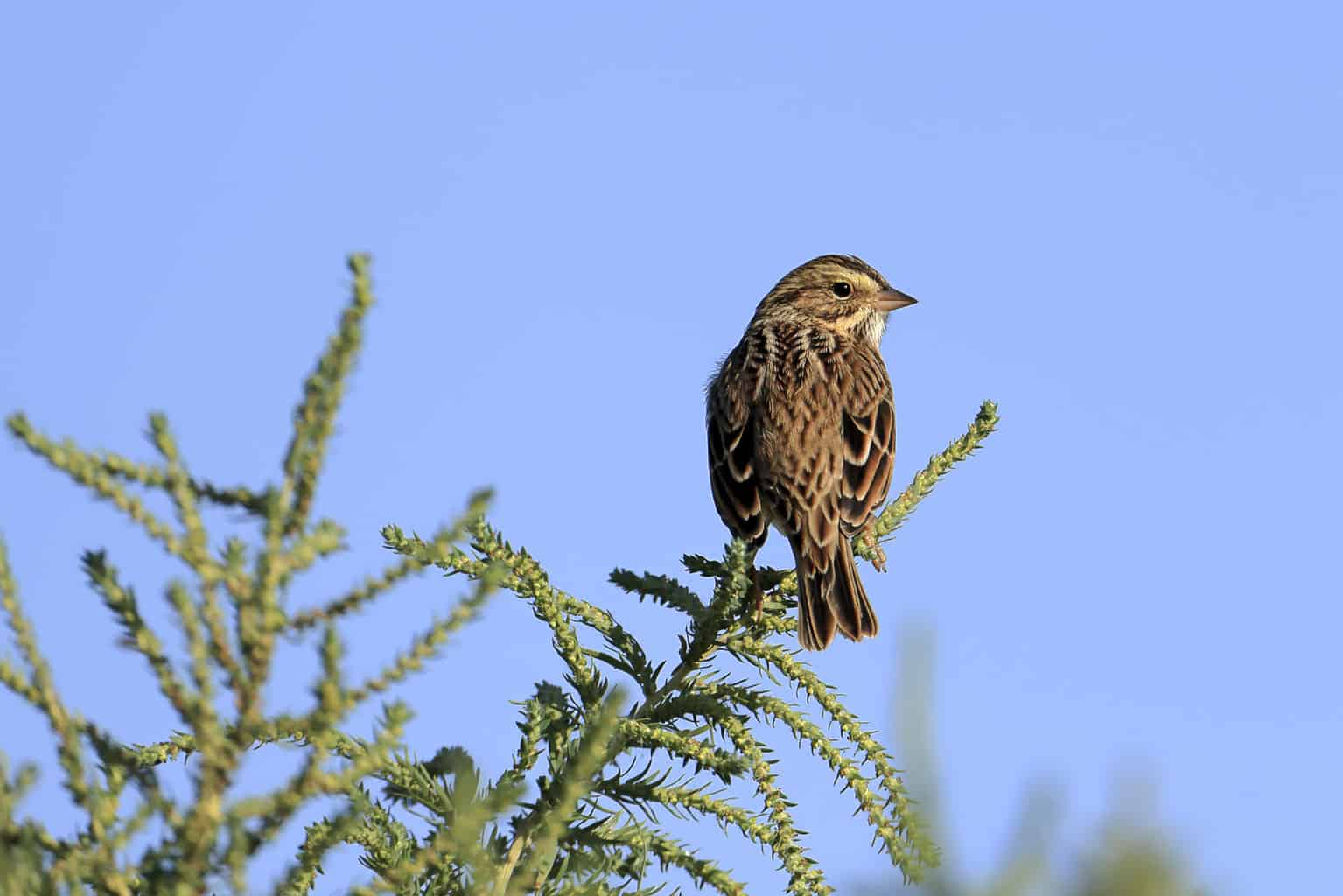
- Melospiza lincolnii
- ORDER: Passeriformes
- FAMILY: Passerellidae
- Length: 5.1-5.9 in (13-15 cm)
- Weight: 0.6-0.7 oz (17-19 g)
- Wingspan: 7.5-8.7 in (19-22 cm)
There aren’t very many helpful cues for identifying a Lincoln’s Sparrow. They have plain gray and brown bodies with a pale white belly and a light-colored “mustache” facial marking. Their crown is brown, and they have a gray stripe in the middle.
Lincoln’s Sparrows are migratory visitors to Kentucky. They migrate in groups with other sparrows, including Song Sparrows and Swamp Sparrows. In other states, they also spend time in groups with White-Crowned Sparrows. During the winter, they are more solitary and spend time in pairs or very small groups.
Lincoln’s Sparrows start their northward migration between late March and May. Their fall migration south begins in September.
Nelson’s Sparrow
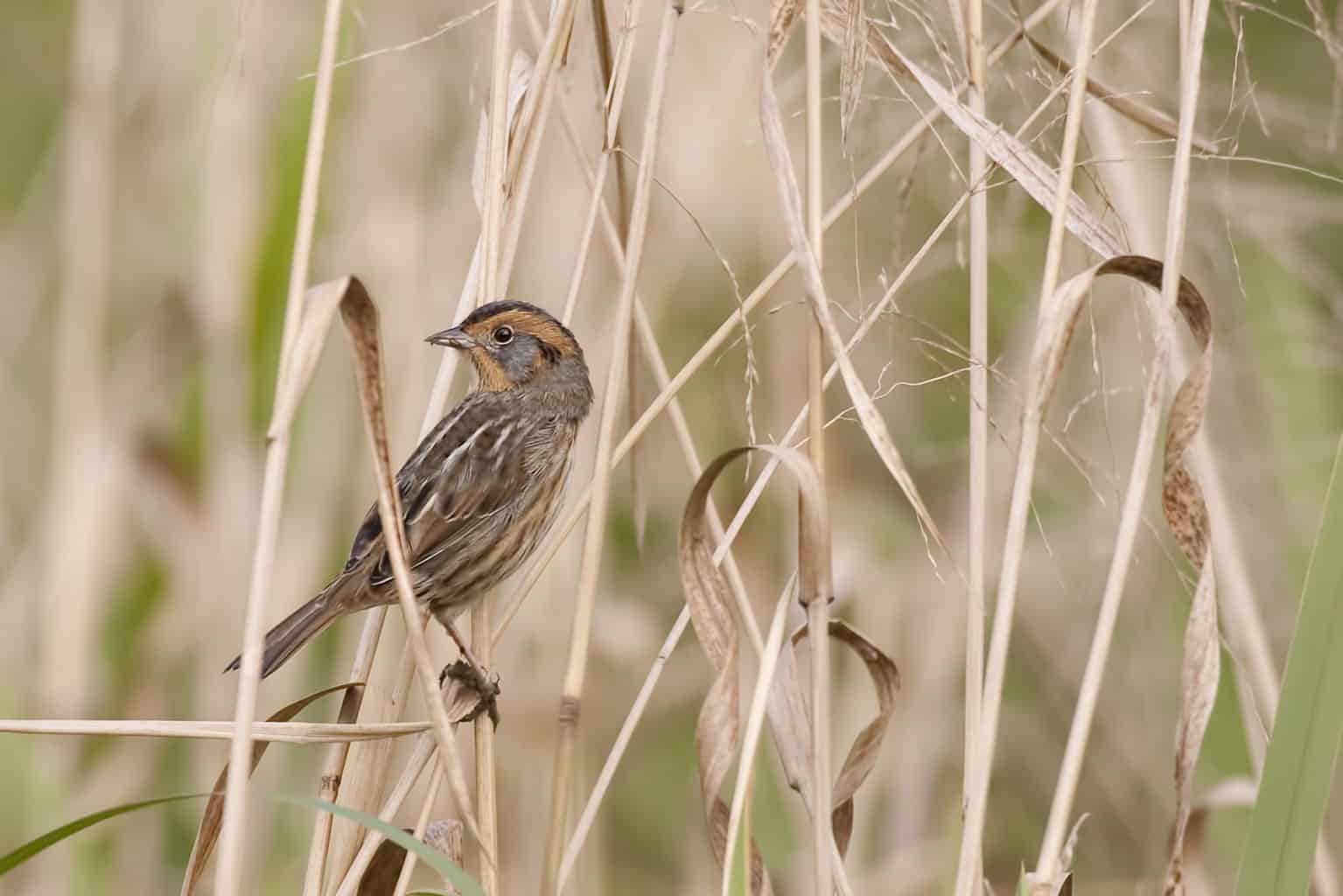
- Ammospiza nelsoni
- ORDER: Passeriformes
- FAMILY: Passerellidae
- Length: 4.3-5.1 in (11-13 cm)
- Weight: 0.6-0.7 oz (17-21 g)
- Wingspan: 6.5-7.9 in (16.5-20 cm)
The Nelson’s Sparrow’s light yellow coloring makes him stand out from many other sparrows. However, there is a lot of regional variation in this species. Coastal Nelson’s Sparrows tend to be lighter in color, whereas the inland Nelson’s Sparrows that migrate through Kentucky are usually darker.
Nelson’s Sparrows and Saltmarsh Sparrows used to be counted as just one species: the Sharp-Tailed Sparrow. In 1998, a distinction was made between them.
You will only find Nelson’s Sparrows in Kentucky during their migration window. They can be found in far western Kentucky as they make their way from Canada to the Atlantic and Gulf Coasts, where they will spend the winter along the saltmarshes.
Savannah Sparrow
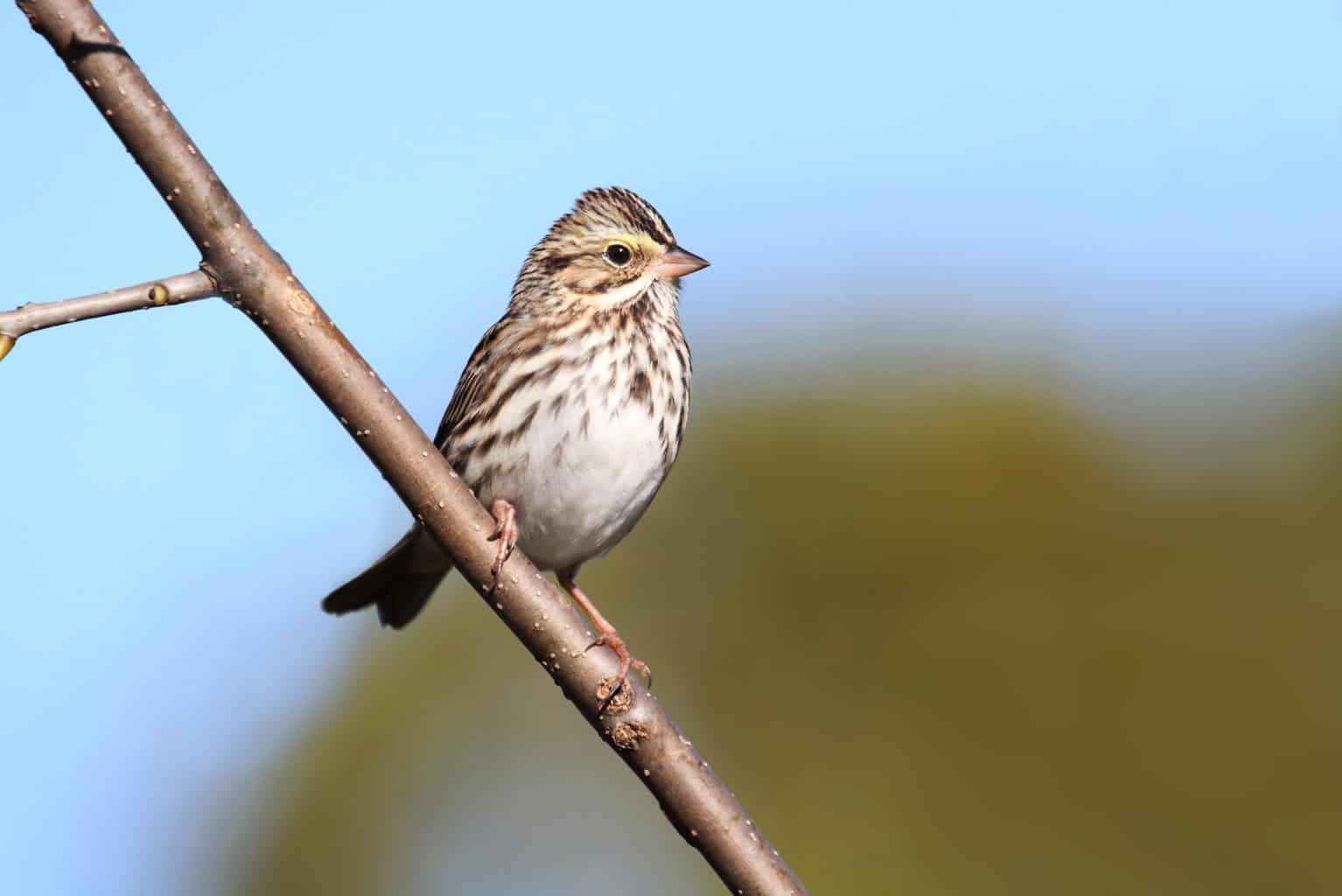
- Passerculus sandwichensis
- ORDER: Passeriformes
- FAMILY: Passerellidae
- Length: 4.3-5.9 in (11-15 cm)
- Weight: 0.5-1.0 oz (15-28 g)
- Wingspan: 7.9-8.7 in (20-22 cm)
The Savannah Sparrow has a noticeable patch of yellow between its eyes and its bill – very handy for quick identification! Their wings and backs are covered in dark streaks, and they have a sharp little bill.
Savannah Sparrows are widespread across most of Canada and the US. They are migratory visitors to western Kentucky, and some will stay in the eastern edge of the state for the summer.
They live in meadows and pastures and can even be spotted in the grass alongside busy roadways. They really like cover-crop fields, especially Alfalfa. That’s perfect in Kentucky, which grows alfalfa on about 270,000 acres of land every year.
Vesper Sparrow
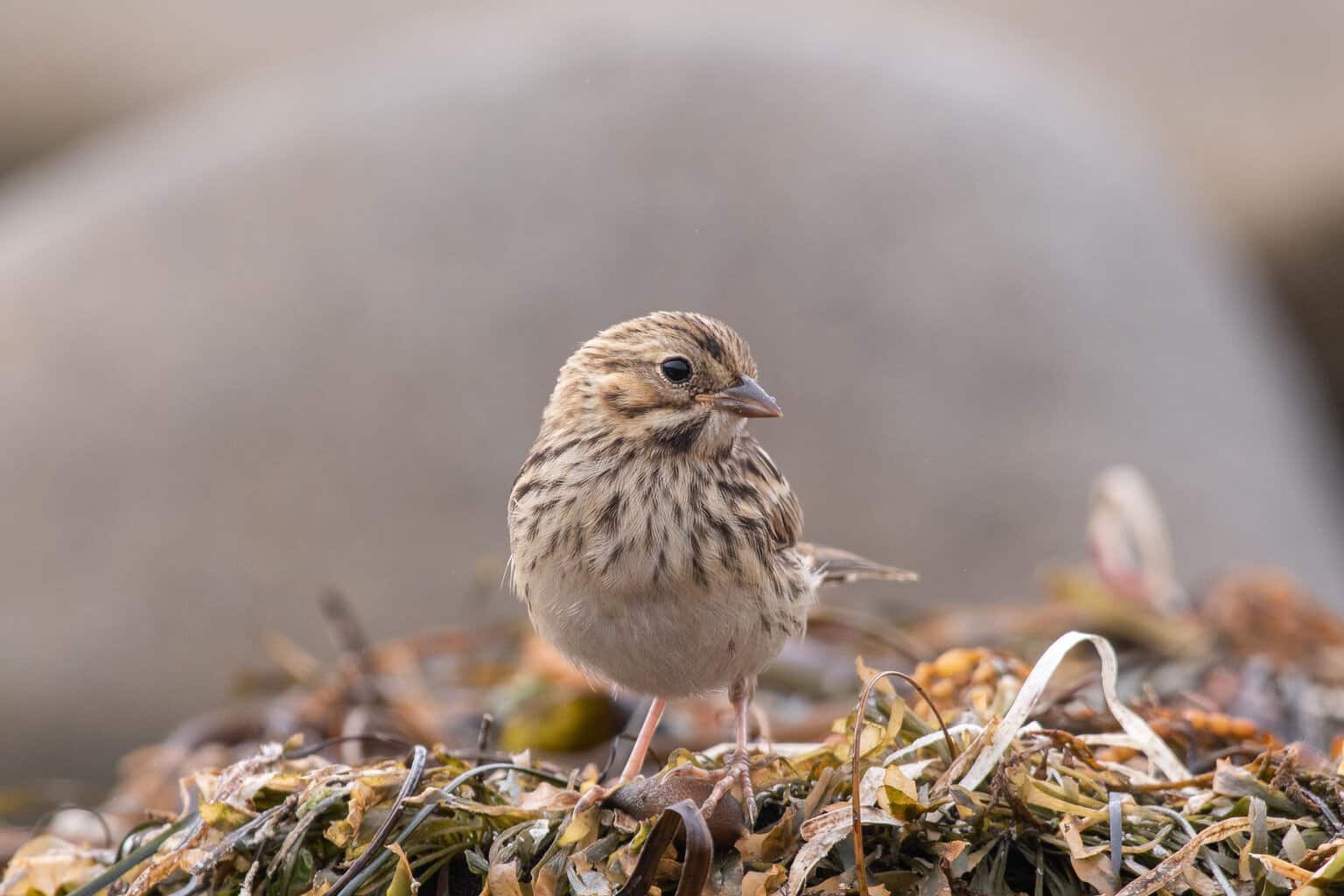
- Pooecetes gramineus
- ORDER: Passeriformes
- FAMILY: Passerellidae
- Length: 5.1-6.3 in (13-16 cm)
- Weight: 0.7-1.0 oz (20-28 g)
- Wingspan: 9.4 in (24 cm)
These large sparrows are some of the biggest sparrows in North America. Of course, the biggest sparrows are still small birds compared to the other birdlife on the continent.
Vesper Sparrows get their name from the beautiful, melodic song they sing at sundown. That’s the same time of day that some Christian traditions hold a Vespers service for evening prayers.
Vespers Sparrows are chestnut-brown on their shoulders and have brown streaking over most of their body. They have white eyerings, too.
They are almost exclusively found during their migration windows in Kentucky, although some stay for the summer along the Ohio River. In the Ohio River Valley, their nests will be found on the ground, often beside a fallen tree or log.
Finding Sparrows in Kentucky
Now that you know about all of these different sparrows in Kentucky, you can start looking for them – and identifying them!
With so many kinds of sparrows, there are always little differences to notice.

